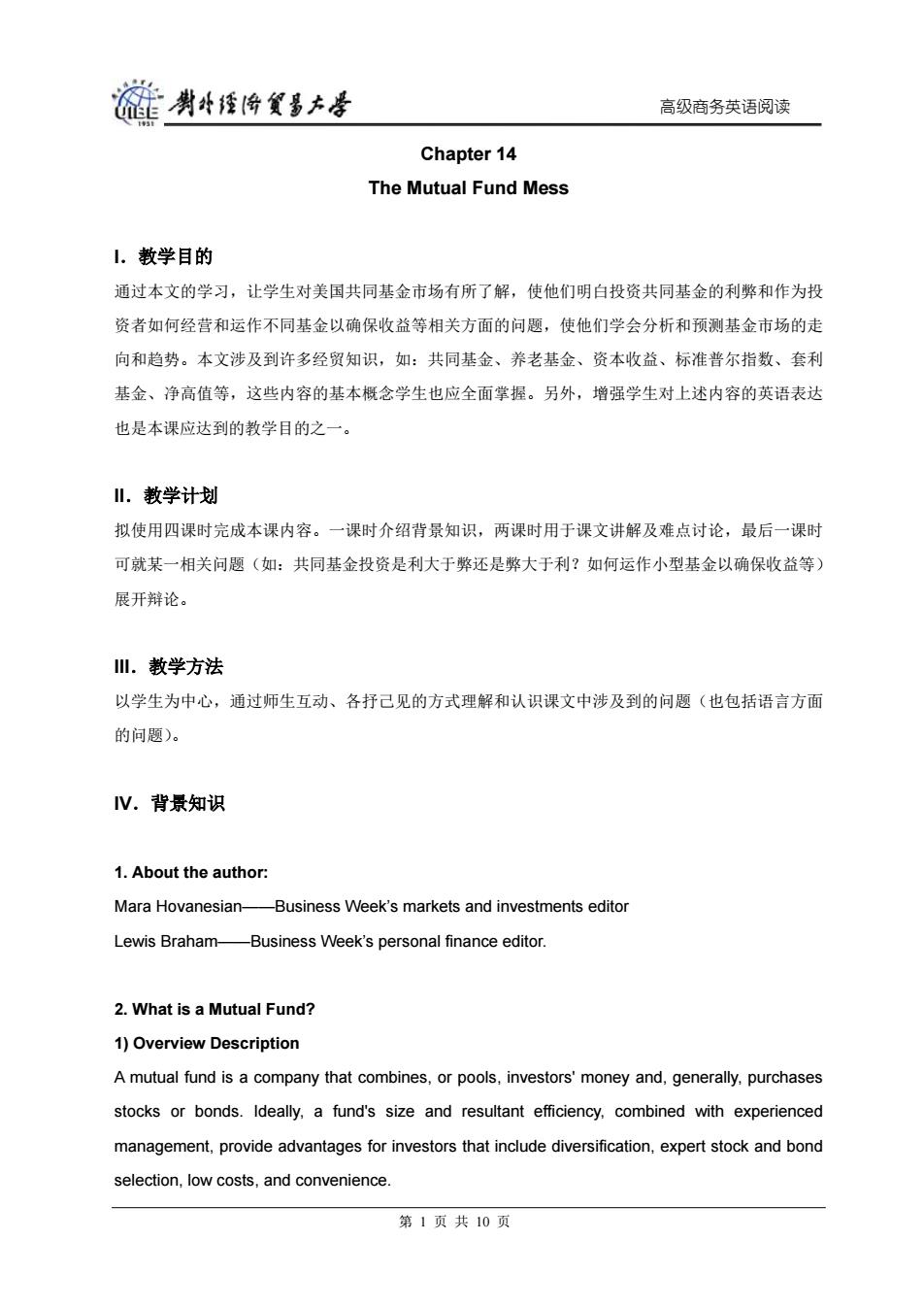
莲喇母矮降贸多大学 高级商务英语阅读 Chapter 14 The Mutual Fund Mess 1.教学目的 通过本文的学习,让学生对美国共同基金市场有所了解,使他们明白投资共同基金的利弊和作为投 资者如何经营和运作不同基金以确保收益等相关方面的问题,使他们学会分析和预测基金市场的走 向和趋势。本文涉及到许多经贸知识,如:共同基金、养老基金、资本收益、标准普尔指数、套利 基金、净高值等,这些内容的基本概念学生也应全面掌握。另外,增强学生对上述内容的英语表达 也是本课应达到的教学目的之一。 Ⅱ.教学计划 拟使用四课时完成本课内容。一课时介绍背景知识,两课时用于课文讲解及难点讨论,最后一课时 可就某一相关问题(如:共同基金投资是利大于弊还是弊大于利?如何运作小型基金以确保收益等) 展开辩论。 川.教学方法 以学生为中心,通过师生互动、各抒己见的方式理解和认识课文中涉及到的问题(也包括语言方面 的问题)。 IV.背景知识 1.About the author: Mara Hovanesian-Business Week's markets and investments editor Lewis Braham-Business Week's personal finance editor. 2.What is a Mutual Fund? 1)Overview Description A mutual fund is a company that combines,or pools,investors'money and,generally,purchases stocks or bonds.Ideally,a fund's size and resultant efficiency,combined with experienced management,provide advantages for investors that include diversification,expert stock and bond selection,low costs,and convenience 第1页共10页
高级商务英语阅读 Chapter 14 The Mutual Fund Mess I.教学目的 通过本文的学习,让学生对美国共同基金市场有所了解,使他们明白投资共同基金的利弊和作为投 资者如何经营和运作不同基金以确保收益等相关方面的问题,使他们学会分析和预测基金市场的走 向和趋势。本文涉及到许多经贸知识,如:共同基金、养老基金、资本收益、标准普尔指数、套利 基金、净高值等,这些内容的基本概念学生也应全面掌握。另外,增强学生对上述内容的英语表达 也是本课应达到的教学目的之一。 II.教学计划 拟使用四课时完成本课内容。一课时介绍背景知识,两课时用于课文讲解及难点讨论,最后一课时 可就某一相关问题(如:共同基金投资是利大于弊还是弊大于利?如何运作小型基金以确保收益等) 展开辩论。 III.教学方法 以学生为中心,通过师生互动、各抒己见的方式理解和认识课文中涉及到的问题(也包括语言方面 的问题)。 IV.背景知识 1. About the author: Mara Hovanesian——Business Week’s markets and investments editor Lewis Braham——Business Week’s personal finance editor. 2. What is a Mutual Fund? 1) Overview Description A mutual fund is a company that combines, or pools, investors' money and, generally, purchases stocks or bonds. Ideally, a fund's size and resultant efficiency, combined with experienced management, provide advantages for investors that include diversification, expert stock and bond selection, low costs, and convenience. 第 1 页 共 10 页
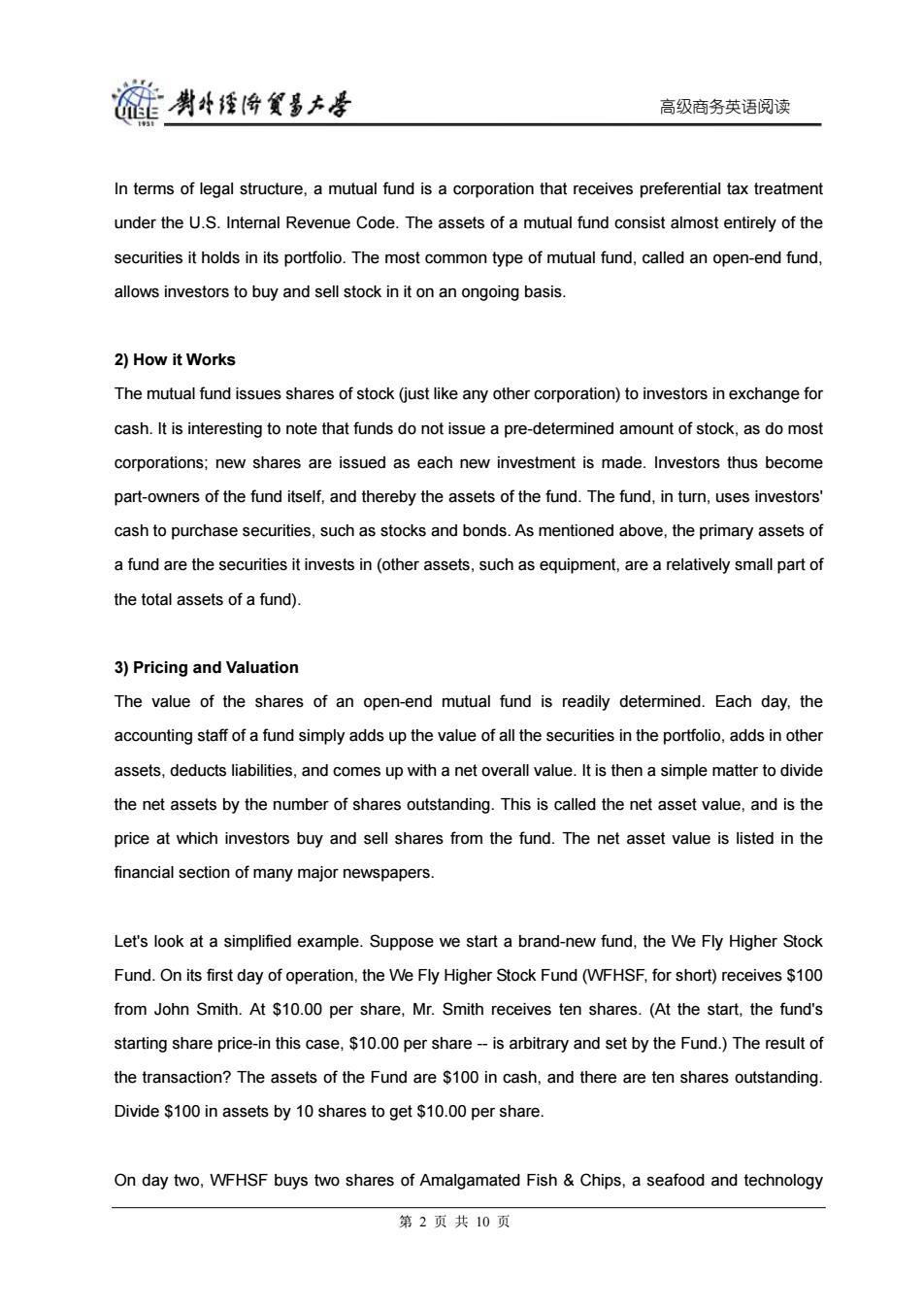
链男牛经海食多大学 高级商务英语阅读 In terms of legal structure,a mutual fund is a corporation that receives preferential tax treatment under the U.S.Internal Revenue Code.The assets of a mutual fund consist almost entirely of the securities it holds in its portfolio.The most common type of mutual fund,called an open-end fund, allows investors to buy and sell stock in it on an ongoing basis. 2)How it Works The mutual fund issues shares of stock(just like any other corporation)to investors in exchange for cash.It is interesting to note that funds do not issue a pre-determined amount of stock,as do most corporations;new shares are issued as each new investment is made.Investors thus become part-owners of the fund itself,and thereby the assets of the fund.The fund,in turn,uses investors' cash to purchase securities,such as stocks and bonds.As mentioned above,the primary assets of a fund are the securities it invests in(other assets,such as equipment,are a relatively small part of the total assets of a fund). 3)Pricing and Valuation The value of the shares of an open-end mutual fund is readily determined.Each day,the accounting staff of a fund simply adds up the value of all the securities in the portfolio,adds in other assets,deducts liabilities,and comes up with a net overall value.It is then a simple matter to divide the net assets by the number of shares outstanding.This is called the net asset value,and is the price at which investors buy and sell shares from the fund.The net asset value is listed in the financial section of many major newspapers. Let's look at a simplified example.Suppose we start a brand-new fund,the We Fly Higher Stock Fund.On its first day of operation,the We Fly Higher Stock Fund (WFHSF,for short)receives $100 from John Smith.At $10.00 per share,Mr.Smith receives ten shares.(At the start,the fund's starting share price-in this case,$10.00 per share--is arbitrary and set by the Fund.)The result of the transaction?The assets of the Fund are $100 in cash,and there are ten shares outstanding. Divide $100 in assets by 10 shares to get $10.00 per share. On day two,WFHSF buys two shares of Amalgamated Fish Chips,a seafood and technology 第2页共10页
高级商务英语阅读 In terms of legal structure, a mutual fund is a corporation that receives preferential tax treatment under the U.S. Internal Revenue Code. The assets of a mutual fund consist almost entirely of the securities it holds in its portfolio. The most common type of mutual fund, called an open-end fund, allows investors to buy and sell stock in it on an ongoing basis. 2) How it Works The mutual fund issues shares of stock (just like any other corporation) to investors in exchange for cash. It is interesting to note that funds do not issue a pre-determined amount of stock, as do most corporations; new shares are issued as each new investment is made. Investors thus become part-owners of the fund itself, and thereby the assets of the fund. The fund, in turn, uses investors' cash to purchase securities, such as stocks and bonds. As mentioned above, the primary assets of a fund are the securities it invests in (other assets, such as equipment, are a relatively small part of the total assets of a fund). 3) Pricing and Valuation The value of the shares of an open-end mutual fund is readily determined. Each day, the accounting staff of a fund simply adds up the value of all the securities in the portfolio, adds in other assets, deducts liabilities, and comes up with a net overall value. It is then a simple matter to divide the net assets by the number of shares outstanding. This is called the net asset value, and is the price at which investors buy and sell shares from the fund. The net asset value is listed in the financial section of many major newspapers. Let's look at a simplified example. Suppose we start a brand-new fund, the We Fly Higher Stock Fund. On its first day of operation, the We Fly Higher Stock Fund (WFHSF, for short) receives $100 from John Smith. At $10.00 per share, Mr. Smith receives ten shares. (At the start, the fund's starting share price-in this case, $10.00 per share -- is arbitrary and set by the Fund.) The result of the transaction? The assets of the Fund are $100 in cash, and there are ten shares outstanding. Divide $100 in assets by 10 shares to get $10.00 per share. On day two, WFHSF buys two shares of Amalgamated Fish & Chips, a seafood and technology 第 2 页 共 10 页
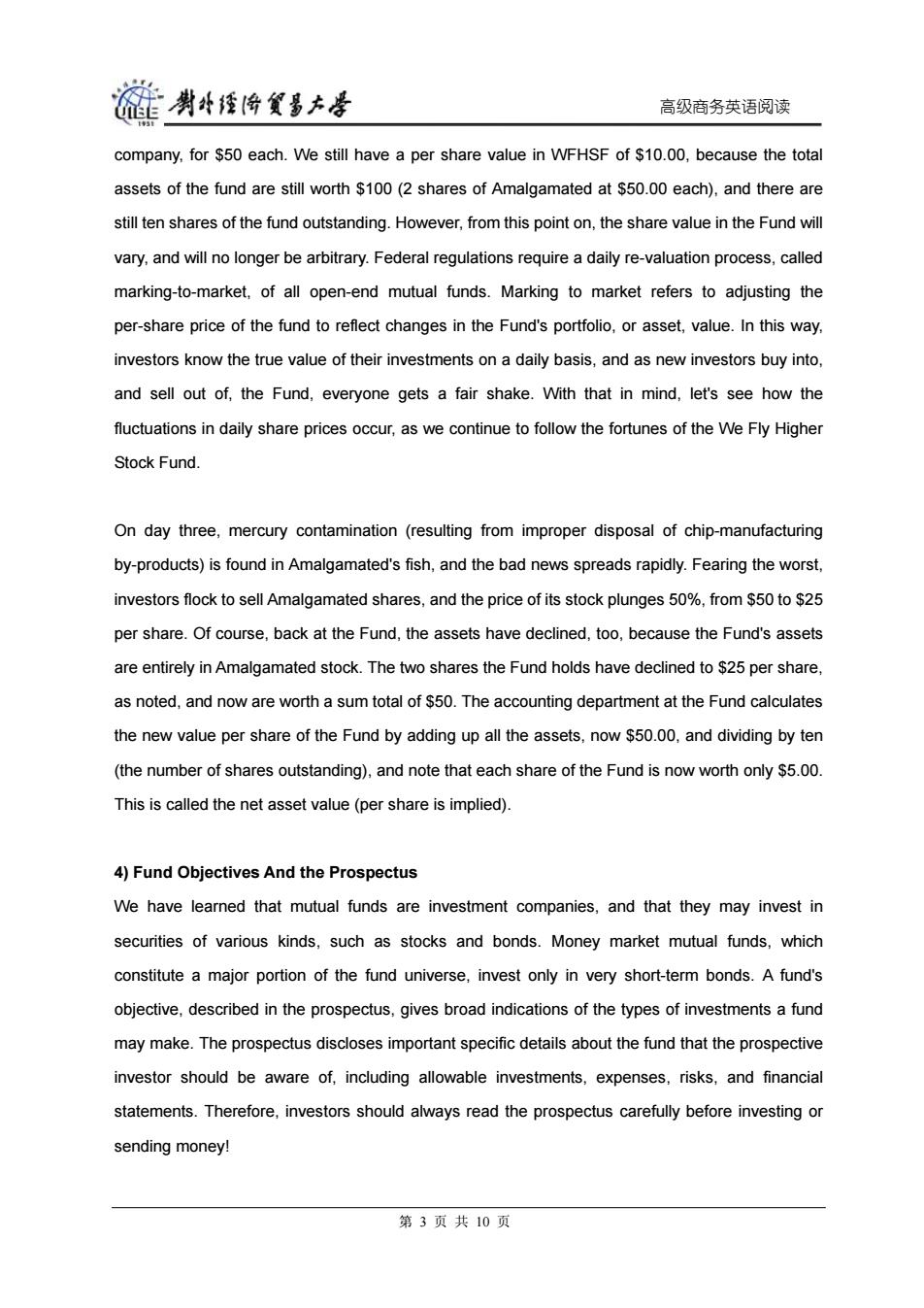
链剥挂将发多大是 高级商务英语阅读 company,for $50 each.We still have a per share value in WFHSF of $10.00,because the total assets of the fund are still worth $100(2 shares of Amalgamated at $50.00 each),and there are still ten shares of the fund outstanding.However,from this point on,the share value in the Fund will vary,and will no longer be arbitrary.Federal regulations require a daily re-valuation process,called marking-to-market,of all open-end mutual funds.Marking to market refers to adjusting the per-share price of the fund to reflect changes in the Fund's portfolio,or asset,value.In this way. investors know the true value of their investments on a daily basis,and as new investors buy into, and sell out of,the Fund,everyone gets a fair shake.With that in mind,let's see how the fluctuations in daily share prices occur,as we continue to follow the fortunes of the We Fly Higher Stock Fund. On day three,mercury contamination (resulting from improper disposal of chip-manufacturing by-products)is found in Amalgamated's fish,and the bad news spreads rapidly.Fearing the worst, investors flock to sell Amalgamated shares,and the price of its stock plunges 50%,from $50 to $25 per share.Of course,back at the Fund,the assets have declined,too,because the Fund's assets are entirely in Amalgamated stock.The two shares the Fund holds have declined to $25 per share, as noted,and now are worth a sum total of $50.The accounting department at the Fund calculates the new value per share of the Fund by adding up all the assets,now $50.00,and dividing by ten (the number of shares outstanding),and note that each share of the Fund is now worth only $5.00. This is called the net asset value(per share is implied). 4)Fund Objectives And the Prospectus We have learned that mutual funds are investment companies,and that they may invest in securities of various kinds,such as stocks and bonds.Money market mutual funds,which constitute a major portion of the fund universe,invest only in very short-term bonds.A fund's objective,described in the prospectus,gives broad indications of the types of investments a fund may make.The prospectus discloses important specific details about the fund that the prospective investor should be aware of,including allowable investments,expenses,risks,and financial statements.Therefore,investors should always read the prospectus carefully before investing or sending money! 第3页共10页
高级商务英语阅读 company, for $50 each. We still have a per share value in WFHSF of $10.00, because the total assets of the fund are still worth $100 (2 shares of Amalgamated at $50.00 each), and there are still ten shares of the fund outstanding. However, from this point on, the share value in the Fund will vary, and will no longer be arbitrary. Federal regulations require a daily re-valuation process, called marking-to-market, of all open-end mutual funds. Marking to market refers to adjusting the per-share price of the fund to reflect changes in the Fund's portfolio, or asset, value. In this way, investors know the true value of their investments on a daily basis, and as new investors buy into, and sell out of, the Fund, everyone gets a fair shake. With that in mind, let's see how the fluctuations in daily share prices occur, as we continue to follow the fortunes of the We Fly Higher Stock Fund. On day three, mercury contamination (resulting from improper disposal of chip-manufacturing by-products) is found in Amalgamated's fish, and the bad news spreads rapidly. Fearing the worst, investors flock to sell Amalgamated shares, and the price of its stock plunges 50%, from $50 to $25 per share. Of course, back at the Fund, the assets have declined, too, because the Fund's assets are entirely in Amalgamated stock. The two shares the Fund holds have declined to $25 per share, as noted, and now are worth a sum total of $50. The accounting department at the Fund calculates the new value per share of the Fund by adding up all the assets, now $50.00, and dividing by ten (the number of shares outstanding), and note that each share of the Fund is now worth only $5.00. This is called the net asset value (per share is implied). 4) Fund Objectives And the Prospectus We have learned that mutual funds are investment companies, and that they may invest in securities of various kinds, such as stocks and bonds. Money market mutual funds, which constitute a major portion of the fund universe, invest only in very short-term bonds. A fund's objective, described in the prospectus, gives broad indications of the types of investments a fund may make. The prospectus discloses important specific details about the fund that the prospective investor should be aware of, including allowable investments, expenses, risks, and financial statements. Therefore, investors should always read the prospectus carefully before investing or sending money! 第 3 页 共 10 页
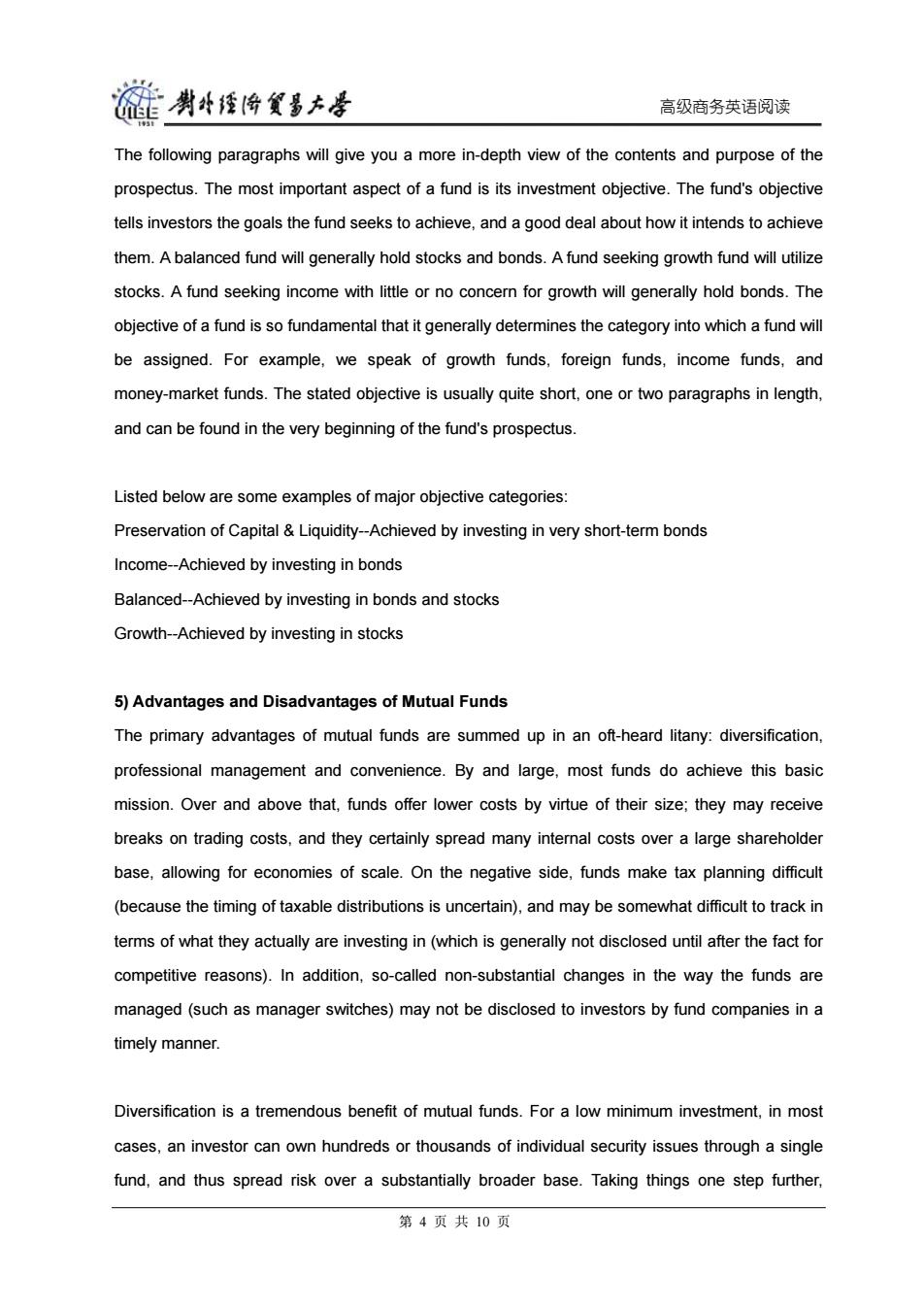
链男4经降贸多大是 高级商务英语阅读 The following paragraphs will give you a more in-depth view of the contents and purpose of the prospectus.The most important aspect of a fund is its investment objective.The fund's objective tells investors the goals the fund seeks to achieve,and a good deal about how it intends to achieve them.A balanced fund will generally hold stocks and bonds.A fund seeking growth fund will utilize stocks.A fund seeking income with little or no concern for growth will generally hold bonds.The objective of a fund is so fundamental that it generally determines the category into which a fund will be assigned.For example,we speak of growth funds,foreign funds,income funds,and money-market funds.The stated objective is usually quite short,one or two paragraphs in length, and can be found in the very beginning of the fund's prospectus. Listed below are some examples of major objective categories: Preservation of Capital Liquidity--Achieved by investing in very short-term bonds Income--Achieved by investing in bonds Balanced--Achieved by investing in bonds and stocks Growth--Achieved by investing in stocks 5)Advantages and Disadvantages of Mutual Funds The primary advantages of mutual funds are summed up in an oft-heard litany:diversification, professional management and convenience.By and large,most funds do achieve this basic mission.Over and above that,funds offer lower costs by virtue of their size;they may receive breaks on trading costs,and they certainly spread many internal costs over a large shareholder base,allowing for economies of scale.On the negative side,funds make tax planning difficult (because the timing of taxable distributions is uncertain),and may be somewhat difficult to track in terms of what they actually are investing in(which is generally not disclosed until after the fact for competitive reasons).In addition,so-called non-substantial changes in the way the funds are managed(such as manager switches)may not be disclosed to investors by fund companies in a timely manner. Diversification is a tremendous benefit of mutual funds.For a low minimum investment,in most cases,an investor can own hundreds or thousands of individual security issues through a single fund,and thus spread risk over a substantially broader base.Taking things one step further, 第4页共10页
高级商务英语阅读 The following paragraphs will give you a more in-depth view of the contents and purpose of the prospectus. The most important aspect of a fund is its investment objective. The fund's objective tells investors the goals the fund seeks to achieve, and a good deal about how it intends to achieve them. A balanced fund will generally hold stocks and bonds. A fund seeking growth fund will utilize stocks. A fund seeking income with little or no concern for growth will generally hold bonds. The objective of a fund is so fundamental that it generally determines the category into which a fund will be assigned. For example, we speak of growth funds, foreign funds, income funds, and money-market funds. The stated objective is usually quite short, one or two paragraphs in length, and can be found in the very beginning of the fund's prospectus. Listed below are some examples of major objective categories: Preservation of Capital & Liquidity--Achieved by investing in very short-term bonds Income--Achieved by investing in bonds Balanced--Achieved by investing in bonds and stocks Growth--Achieved by investing in stocks 5) Advantages and Disadvantages of Mutual Funds The primary advantages of mutual funds are summed up in an oft-heard litany: diversification, professional management and convenience. By and large, most funds do achieve this basic mission. Over and above that, funds offer lower costs by virtue of their size; they may receive breaks on trading costs, and they certainly spread many internal costs over a large shareholder base, allowing for economies of scale. On the negative side, funds make tax planning difficult (because the timing of taxable distributions is uncertain), and may be somewhat difficult to track in terms of what they actually are investing in (which is generally not disclosed until after the fact for competitive reasons). In addition, so-called non-substantial changes in the way the funds are managed (such as manager switches) may not be disclosed to investors by fund companies in a timely manner. Diversification is a tremendous benefit of mutual funds. For a low minimum investment, in most cases, an investor can own hundreds or thousands of individual security issues through a single fund, and thus spread risk over a substantially broader base. Taking things one step further, 第 4 页 共 10 页

链喇哈餐多方孝 高级商务英语阅读 different types of funds allow participation in many types of securities,such as foreign stocks, foreign bonds,real estate securities,technology stocks,small companies,and so on.Thus,a single investor can assemble a portfolio of mutual funds that invest in different asset classes.The chance of any single person being sufficiently well-versed to manage such diverse investments is highly unlikely,even if done full-time!In the extreme,funds may even own other mutual funds, resulting in a virtual all-in-one portfolio.An example of the all-in-one,"fund of funds"approach would be Vanguard's Star Fund.The Star Fund invests in about eight other Vanguard funds with different objectives--small stock,blue chip stock,bonds,etc.-with no additional expenses added onto the low expenses of the underlying funds.Such a fund might serve as an entire investment portfolio for the small investor. The second potential benefit,professional management,is always guaranteed,but sadly,only because managers of funds are paid for their services.Fortunately,truly dismal mutual fund management is rare(I can think of only a handful of cases where investment returns have badly trailed the relevant market measures over substantial periods of time).Finally,there is no doubt that investors benefit from substantial convenience by investing in mutual funds.They are relieved of the day-to-day tasks involved in researching,buying and selling securities.In the case of individual securities,day-to-day vigilance is a virtual requirement,especially in a diversified portfolio,with many holdings.Mutual funds,on the other hand,need not be looked at on a daily, weekly or even monthly basis.Occasional reviews,perhaps once a year,will suffice.(Helpful Hint: the same guidelines and practices for picking a mutual fund in the first place are also useful for fund reviews.) Perhaps the biggest negative aspect of mutual funds is tax-planning difficulty and uncertainty. Funds make taxable distributions in a largely hard-to-foresee manner.In addition,they are required to distribute long-term capital gains in the year realized;thus the investor loses control over the timing of the realization and taxation of capital gains,contrary to the situation where an investor who owns securities outright,can choose sale dates. 2.Small Fund Comes into Being This is the year of the boutique manager.The industry's stars look a lot like Boston Partners Asset 第5页共10页
高级商务英语阅读 different types of funds allow participation in many types of securities, such as foreign stocks, foreign bonds, real estate securities, technology stocks, small companies, and so on. Thus, a single investor can assemble a portfolio of mutual funds that invest in different asset classes. The chance of any single person being sufficiently well-versed to manage such diverse investments is highly unlikely, even if done full-time! In the extreme, funds may even own other mutual funds, resulting in a virtual all-in-one portfolio. An example of the all-in-one, "fund of funds" approach would be Vanguard's Star Fund. The Star Fund invests in about eight other Vanguard funds with different objectives -- small stock, blue chip stock, bonds, etc. -- with no additional expenses added onto the low expenses of the underlying funds. Such a fund might serve as an entire investment portfolio for the small investor. The second potential benefit, professional management, is always guaranteed, but sadly, only because managers of funds are paid for their services. Fortunately, truly dismal mutual fund management is rare (I can think of only a handful of cases where investment returns have badly trailed the relevant market measures over substantial periods of time). Finally, there is no doubt that investors benefit from substantial convenience by investing in mutual funds. They are relieved of the day-to-day tasks involved in researching, buying and selling securities. In the case of individual securities, day-to-day vigilance is a virtual requirement, especially in a diversified portfolio, with many holdings. Mutual funds, on the other hand, need not be looked at on a daily, weekly or even monthly basis. Occasional reviews, perhaps once a year, will suffice. (Helpful Hint: the same guidelines and practices for picking a mutual fund in the first place are also useful for fund reviews.) Perhaps the biggest negative aspect of mutual funds is tax-planning difficulty and uncertainty. Funds make taxable distributions in a largely hard-to-foresee manner. In addition, they are required to distribute long-term capital gains in the year realized; thus the investor loses control over the timing of the realization and taxation of capital gains, contrary to the situation where an investor who owns securities outright, can choose sale dates. 2. Small Fund Comes into Being This is the year of the boutique manager. The industry's stars look a lot like Boston Partners Asset 第 5 页 共 10 页
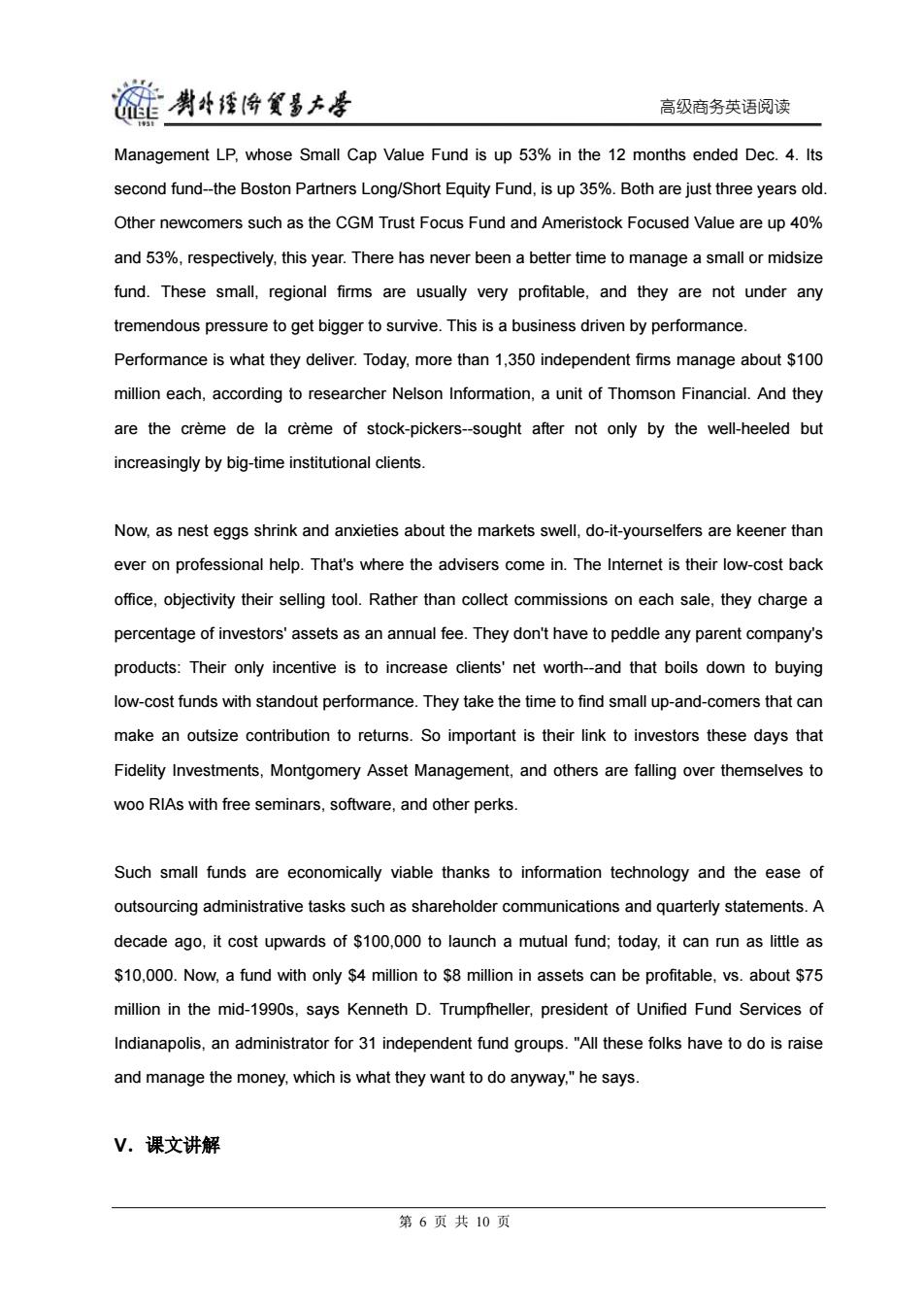
旋类科桂将贸多大 高级商务英语阅读 Management LP,whose Small Cap Value Fund is up 53%in the 12 months ended Dec.4.Its second fund--the Boston Partners Long/Short Equity Fund,is up 35%.Both are just three years old. Other newcomers such as the CGM Trust Focus Fund and Ameristock Focused Value are up 40% and 53%,respectively,this year.There has never been a better time to manage a small or midsize fund.These small,regional firms are usually very profitable,and they are not under any tremendous pressure to get bigger to survive.This is a business driven by performance. Performance is what they deliver.Today,more than 1,350 independent firms manage about $100 million each,according to researcher Nelson Information,a unit of Thomson Financial.And they are the creme de la creme of stock-pickers--sought after not only by the well-heeled but increasingly by big-time institutional clients. Now,as nest eggs shrink and anxieties about the markets swell,do-it-yourselfers are keener than ever on professional help.That's where the advisers come in.The Internet is their low-cost back office,objectivity their selling tool.Rather than collect commissions on each sale,they charge a percentage of investors'assets as an annual fee.They don't have to peddle any parent company's products:Their only incentive is to increase clients'net worth--and that boils down to buying low-cost funds with standout performance.They take the time to find small up-and-comers that can make an outsize contribution to returns.So important is their link to investors these days that Fidelity Investments,Montgomery Asset Management,and others are falling over themselves to woo RIAs with free seminars,software,and other perks. Such small funds are economically viable thanks to information technology and the ease of outsourcing administrative tasks such as shareholder communications and quarterly statements.A decade ago,it cost upwards of $100,000 to launch a mutual fund;today,it can run as little as $10,000.Now,a fund with only $4 million to $8 million in assets can be profitable,vs.about $75 million in the mid-1990s,says Kenneth D.Trumpfheller,president of Unified Fund Services of Indianapolis,an administrator for 31 independent fund groups."All these folks have to do is raise and manage the money,which is what they want to do anyway,"he says. V.课文讲解 第6页共10页
高级商务英语阅读 Management LP, whose Small Cap Value Fund is up 53% in the 12 months ended Dec. 4. Its second fund--the Boston Partners Long/Short Equity Fund, is up 35%. Both are just three years old. Other newcomers such as the CGM Trust Focus Fund and Ameristock Focused Value are up 40% and 53%, respectively, this year. There has never been a better time to manage a small or midsize fund. These small, regional firms are usually very profitable, and they are not under any tremendous pressure to get bigger to survive. This is a business driven by performance. Performance is what they deliver. Today, more than 1,350 independent firms manage about $100 million each, according to researcher Nelson Information, a unit of Thomson Financial. And they are the crème de la crème of stock-pickers--sought after not only by the well-heeled but increasingly by big-time institutional clients. Now, as nest eggs shrink and anxieties about the markets swell, do-it-yourselfers are keener than ever on professional help. That's where the advisers come in. The Internet is their low-cost back office, objectivity their selling tool. Rather than collect commissions on each sale, they charge a percentage of investors' assets as an annual fee. They don't have to peddle any parent company's products: Their only incentive is to increase clients' net worth--and that boils down to buying low-cost funds with standout performance. They take the time to find small up-and-comers that can make an outsize contribution to returns. So important is their link to investors these days that Fidelity Investments, Montgomery Asset Management, and others are falling over themselves to woo RIAs with free seminars, software, and other perks. Such small funds are economically viable thanks to information technology and the ease of outsourcing administrative tasks such as shareholder communications and quarterly statements. A decade ago, it cost upwards of $100,000 to launch a mutual fund; today, it can run as little as $10,000. Now, a fund with only $4 million to $8 million in assets can be profitable, vs. about $75 million in the mid-1990s, says Kenneth D. Trumpfheller, president of Unified Fund Services of Indianapolis, an administrator for 31 independent fund groups. "All these folks have to do is raise and manage the money, which is what they want to do anyway," he says. V.课文讲解 第 6 页 共 10 页
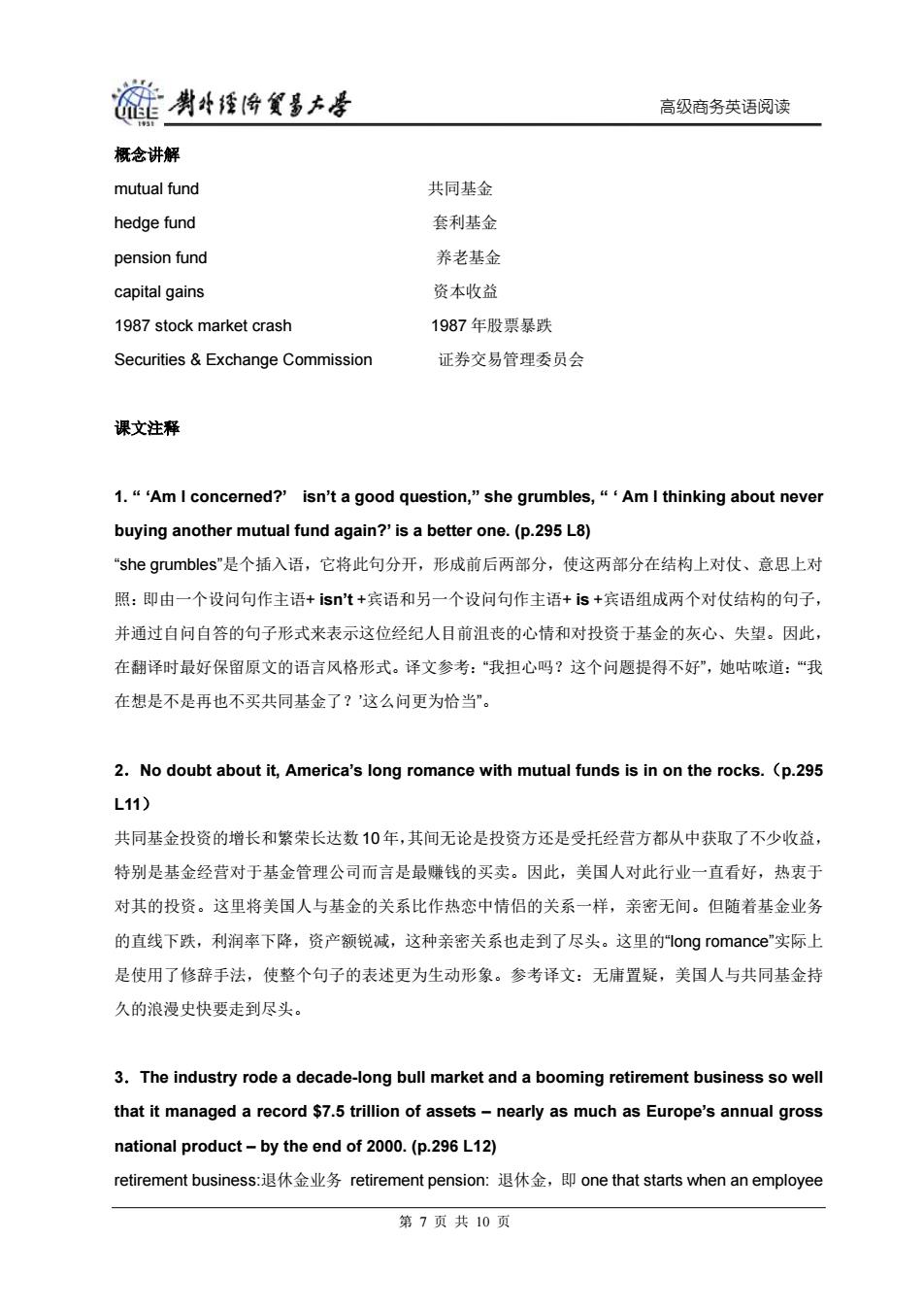
能男牛语降贸多大 高级商务英语阅读 概念讲解 mutual fund 共同基金 hedge fund 套利基金 pension fund 养老基金 capital gains 资本收益 1987 stock market crash 1987年股票暴跌 Securities Exchange Commission 证券交易管理委员会 课文注释 1."'Am I concerned?'isn't a good question,"she grumbles,"Am I thinking about never buying another mutual fund again?'is a better one.(p.295 L8) “she grumbles'"是个插入语,它将此句分开,形成前后两部分,使这两部分在结构上对仗、意思上对 照:即由一个设问句作主语+isn't+宾语和另一个设问句作主语+s+宾语组成两个对仗结构的句子, 并通过自问自答的句子形式来表示这位经纪人目前沮丧的心情和对投资于基金的灰心、失望。因此, 在翻译时最好保留原文的语言风格形式。译文参考:“我担心吗?这个问题提得不好”,她咕哝道:“我 在想是不是再也不买共同基金了?'这么问更为恰当”。 2.No doubt about it,America's long romance with mutual funds is in on the rocks.(p.295 L11) 共同基金投资的增长和繁荣长达数10年,其间无论是投资方还是受托经营方都从中获取了不少收益, 特别是基金经营对于基金管理公司而言是最赚钱的买卖。因此,美国人对此行业一直看好,热衷于 对其的投资。这里将美国人与基金的关系比作热恋中情侣的关系一样,亲密无间。但随着基金业务 的直线下跌,利润率下降,资产额锐减,这种亲密关系也走到了尽头。这里的long romance"实际上 是使用了修辞手法,使整个句子的表述更为生动形象。参考译文:无庸置疑,美国人与共同基金持 久的浪漫史快要走到尽头。 3.The industry rode a decade-long bull market and a booming retirement business so well that it managed a record $7.5 trillion of assets-nearly as much as Europe's annual gross national product-by the end of 2000.(p.296 L12) retirement business:退休金业务retirement pension:退休金,即one that starts when an employee 第7页共10页
高级商务英语阅读 概念讲解 mutual fund 共同基金 hedge fund 套利基金 pension fund 养老基金 capital gains 资本收益 1987 stock market crash 1987 年股票暴跌 Securities & Exchange Commission 证券交易管理委员会 课文注释 1. “ ‘Am I concerned?’ isn’t a good question,” she grumbles, “ ‘ Am I thinking about never buying another mutual fund again?’ is a better one. (p.295 L8) “she grumbles”是个插入语,它将此句分开,形成前后两部分,使这两部分在结构上对仗、意思上对 照:即由一个设问句作主语+ isn’t +宾语和另一个设问句作主语+ is +宾语组成两个对仗结构的句子, 并通过自问自答的句子形式来表示这位经纪人目前沮丧的心情和对投资于基金的灰心、失望。因此, 在翻译时最好保留原文的语言风格形式。译文参考:“我担心吗?这个问题提得不好”,她咕哝道:“‘我 在想是不是再也不买共同基金了?’这么问更为恰当”。 2.No doubt about it, America’s long romance with mutual funds is in on the rocks.(p.295 L11) 共同基金投资的增长和繁荣长达数 10 年,其间无论是投资方还是受托经营方都从中获取了不少收益, 特别是基金经营对于基金管理公司而言是最赚钱的买卖。因此,美国人对此行业一直看好,热衷于 对其的投资。这里将美国人与基金的关系比作热恋中情侣的关系一样,亲密无间。但随着基金业务 的直线下跌,利润率下降,资产额锐减,这种亲密关系也走到了尽头。这里的“long romance”实际上 是使用了修辞手法,使整个句子的表述更为生动形象。参考译文:无庸置疑,美国人与共同基金持 久的浪漫史快要走到尽头。 3.The industry rode a decade-long bull market and a booming retirement business so well that it managed a record $7.5 trillion of assets – nearly as much as Europe’s annual gross national product – by the end of 2000. (p.296 L12) retirement business:退休金业务 retirement pension: 退休金,即 one that starts when an employee 第 7 页 共 10 页

碰男降贸多大是 高级商务英语阅读 retires from regular work,and continues until his death.It may be the pension paid by the State under the national insurance scheme or may be an occupational pension. 译文参考:基金行业的发展一路高奏凯歌,它成功驾驭牛市达十年之久,退休金业务亦欣欣向荣。 直至2000年末,它所掌控的资金数量达到了创纪录的75亿美元一几乎等于欧洲的年国民生产总 值。 4.Everybody's boat is sitting on the bottom right now.(p.296 L4) 这句话是一句很生动的比喻。它将共同基金投资市场比作海水,每种基金或基金公司比作在海上行 驶的小舟。海水潮起潮落,市场亦有涨有跌,而现在的状况是:潮水退去,一艘艘行驶的小船即将 触底搁浅,这意味着这个市场已衰弱下滑,风光不再了。 5.Even more pain awaits,as a corps of smaller,low-cost funds with smart managers and decent returns which starts to compete head-on with the behemoths.(p.296 L11) 开头短语的意思是,“使人更加难受的是."“更糟糕的情况还在后头”。“compete head-.on with”,表 示“与..进行面对面地竞争”。“the behemoths”:“庞然大物”,这里指那些著名的大牌基金。文中还 有两个类似的词:the mutual--fund giants(13段)和monolithic(11段)。这句话可译成:更糟糕的 是,头脑灵活的经理们操作着一批小型、低成本、投资回报率不菲的基金与那些庞然大物(大牌基 金)展开了面对面的竞争。 6.In a rush to scoop up every last investment dollar in the 1990s,fund firms bombarded investors with nearly 6,000 funds,many of them mediocre.(p.296 L24) 这句话拟可译为:90年代为了把投资资金一网打尽,基金公司争相圈钱,疯狂地推出了近6000种 基金,其中许多都表现平庸。scoop up:“抢先获得“。every last::是口语,表示,“每一个,全部, 无一例外。”mediocre表示:“普普通通、平庸的,"如:a person of mediocre abilities能力平庸之辈。 7.Many fund execs still earn more than Wall Street tycoons:Mario J.Gabilli Assent Management Inc.raked in $45.5 million in 2000,while Lawrence J.Lasser at Marsh Mclennan's Putnam Funds pulled in $35.2 million,including options and other cash payouts. (p.298L9) 此句较长,是由连词while连接的两个并列句。这句话中有几个表示口语的单词,如execs(经理、 主管人员)、rake in(大量敛集钱财)、pull in(获取利润、报酬等)。全句意思是:许多基金公司的 第8页共10页
高级商务英语阅读 retires from regular work, and continues until his death. It may be the pension paid by the State under the national insurance scheme or may be an occupational pension. 译文参考:基金行业的发展一路高奏凯歌,它成功驾驭牛市达十年之久,退休金业务亦欣欣向荣。 直至 2000 年末,它所掌控的资金数量达到了创纪录的 75 亿美元——几乎等于欧洲的年国民生产总 值。 4.Everybody’s boat is sitting on the bottom right now. (p.296 L4) 这句话是一句很生动的比喻。它将共同基金投资市场比作海水,每种基金或基金公司比作在海上行 驶的小舟。海水潮起潮落,市场亦有涨有跌,而现在的状况是:潮水退去,一艘艘行驶的小船即将 触底搁浅,这意味着这个市场已衰弱下滑,风光不再了。 5.Even more pain awaits, as a corps of smaller, low-cost funds with smart managers and decent returns which starts to compete head-on with the behemoths. (p.296 L11) 开头短语的意思是,“使人更加难受的是……”“更糟糕的情况还在后头”。“compete head-on with”,表 示“与……进行面对面地竞争”。“the behemoths”:“庞然大物”,这里指那些著名的大牌基金。文中还 有两个类似的词:the mutual-fund giants(13 段)和 monolithic(11 段)。这句话可译成:更糟糕的 是, 头脑灵活的经理们操作着一批小型、低成本、投资回报率不菲的基金与那些庞然大物(大牌基 金)展开了面对面的竞争。 6.In a rush to scoop up every last investment dollar in the 1990s, fund firms bombarded investors with nearly 6,000 funds, many of them mediocre. (p.296 L24) 这句话拟可译为:90 年代为了把投资资金一网打尽,基金公司争相圈钱,疯狂地推出了近 6000 种 基金,其中许多都表现平庸。scoop up:“抢先获得“。every last:是口语,表示,“每一个,全部, 无一例外。”mediocre 表示:“普普通通、平庸的,”如:a person of mediocre abilities 能力平庸之辈。 7.Many fund execs still earn more than Wall Street tycoons: Mario J. Gabilli Assent Management Inc. raked in $45.5 million in 2000, while Lawrence J. Lasser at Marsh & Mclennan’s Putnam Funds pulled in $35.2 million, including options and other cash payouts. (p. 298 L9) 此句较长,是由连词 while 连接的两个并列句。这句话中有几个表示口语的单词,如 execs(经理、 主管人员)、rake in(大量敛集钱财)、pull in(获取利润、报酬等)。全句意思是:许多基金公司的 第 8 页 共 10 页

雒剥经降置昌大是 高级商务英语阅读 经理还是比华尔街大亨们挣得多:基金管理公司的经理玛瑞欧J伽比利2000年掠进4550万美元, 与此同时玛斯和麦克里南的普特南基金经理劳伦斯J·莱瑟赚到了3520万美元,包括期权和现金股 息。 8.SIG Chief Executive Hilda Ochoa-Brillembourg says big brand-name funds are a potential "toxic-waste site"for the baby boomers'retirement hopes."All I see in their future is downside risk and very little upside potential,"she says.(p297 L16) toxic::poisonous有毒的e.g.toxic waste from a factory工厂排出的有毒废物baby boomer::生育高 峰期出生的人,婴儿潮期间出生的人 译文参考:战略投资集团(SG)的首席执行官希尔德·奥恰布里伦伯说,对于在婴儿潮期间出生的人 的退休梦来说,大牌基金是个潜在的“有毒废料堆积场”。她说:“我看到的将来,只有下滑的危险, 少有上升的潜质。” 9.They offer what mutual funds do not:more transparency and tax-efficiency.(p.299 L15) 这句话的意思是说在今后几年内,富裕家庭拥有的共同基金将有一半以上转到分立帐户中,这些客 户化的产品按客户的要求定制,与共同基金相比,他们的优势在于具有更高的透明度和税收效率。 tax efficiency:the ability of a tax-payer to invest his capital in such a way that the amount of tax pay able on the income from it is kept as small as possible.税收效率。一个纳税人将其资本以下述方式 投资的能力,即,使得从投资得到的收入的应纳税金额尽可能达到最小。 10.Still,Vanguard isn't resting on its laurel.(p.300 L12) rest/sit on one's laurels:满足于既得荣誉,固步自封,如:These companies sat on their laurels after they defeated their competitors in the stock market.这些公司在击败了股票市场的对手后就满足于 现状了。aurels:月桂枝叶。古代希腊人和罗马人用以编成冠冕,授与杰出的诗人、英雄或竞技优胜 者。此句的参考译文:然而,前锋公司并没有自持业绩而沾沾自喜,停滞不前。 11.Their worst tactic would be to sit back and wait for the market to recover-and the money to start rolling in again.It may well not.(p.300 L21) 全句的大意是:其下下策是坐等市场恢复一金钱重新滚滚而来。这样的机会也许不会再来了。St back:在一旁闲着,如:Sit back and let others work.自己在旁边闲着尽让别人干活。 It may well not..这是全文的最后一句,也是提纲擎领的总结。严格地说,在语法上这不是一个很完 第9页共10页
高级商务英语阅读 经理还是比华尔街大亨们挣得多:基金管理公司的经理玛瑞欧·J ·伽比利 2000 年掠进 4550 万美元, 与此同时玛斯和麦克里南的普特南基金经理劳伦斯·J ·莱瑟赚到了 3520 万美元,包括期权和现金股 息。 8. SIG Chief Executive Hilda Ochoa-Brillembourg says big brand-name funds are a potential “toxic-waste site” for the baby boomers’ retirement hopes. “All I see in their future is downside risk and very little upside potential,” she says. (p297 L16) toxic: poisonous 有毒的 e.g. toxic waste from a factory 工厂排出的有毒废物 baby boomer:生育高 峰期出生的人,婴儿潮期间出生的人 译文参考:战略投资集团(SIG)的首席执行官希尔德•奥恰•布里伦伯说,对于在婴儿潮期间出生的人 的退休梦来说,大牌基金是个潜在的“有毒废料堆积场”。她说:“我看到的将来,只有下滑的危险, 少有上升的潜质。” 9.They offer what mutual funds do not:more transparency and tax-efficiency. (p.299 L15) 这句话的意思是说在今后几年内,富裕家庭拥有的共同基金将有一半以上转到分立帐户中,这些客 户化的产品按客户的要求定制,与共同基金相比,他们的优势在于具有更高的透明度和税收效率。 tax efficiency: the ability of a tax-payer to invest his capital in such a way that the amount of tax pay able on the income from it is kept as small as possible.税收效率。一个纳税人将其资本以下述方式 投资的能力,即,使得从投资得到的收入的应纳税金额尽可能达到最小。 10.Still, Vanguard isn’t resting on its laurel. (p.300 L12) rest/sit on one’s laurels:满足于既得荣誉,固步自封,如:These companies sat on their laurels after they defeated their competitors in the stock market.这些公司在击败了股票市场的对手后就满足于 现状了。laurels:月桂枝叶。古代希腊人和罗马人用以编成冠冕,授与杰出的诗人、英雄或竞技优胜 者。此句的参考译文:然而,前锋公司并没有自持业绩而沾沾自喜,停滞不前。 11.Their worst tactic would be to sit back and wait for the market to recover——and the money to start rolling in again. It may well not. (p.300 L21) 全句的大意是:其下下策是坐等市场恢复——金钱重新滚滚而来。这样的机会也许不会再来了。sit back:在一旁闲着,如:Sit back and let others work. 自己在旁边闲着尽让别人干活。 It may well not. 这是全文的最后一句,也是提纲擎领的总结。严格地说,在语法上这不是一个很完 第 9 页 共 10 页
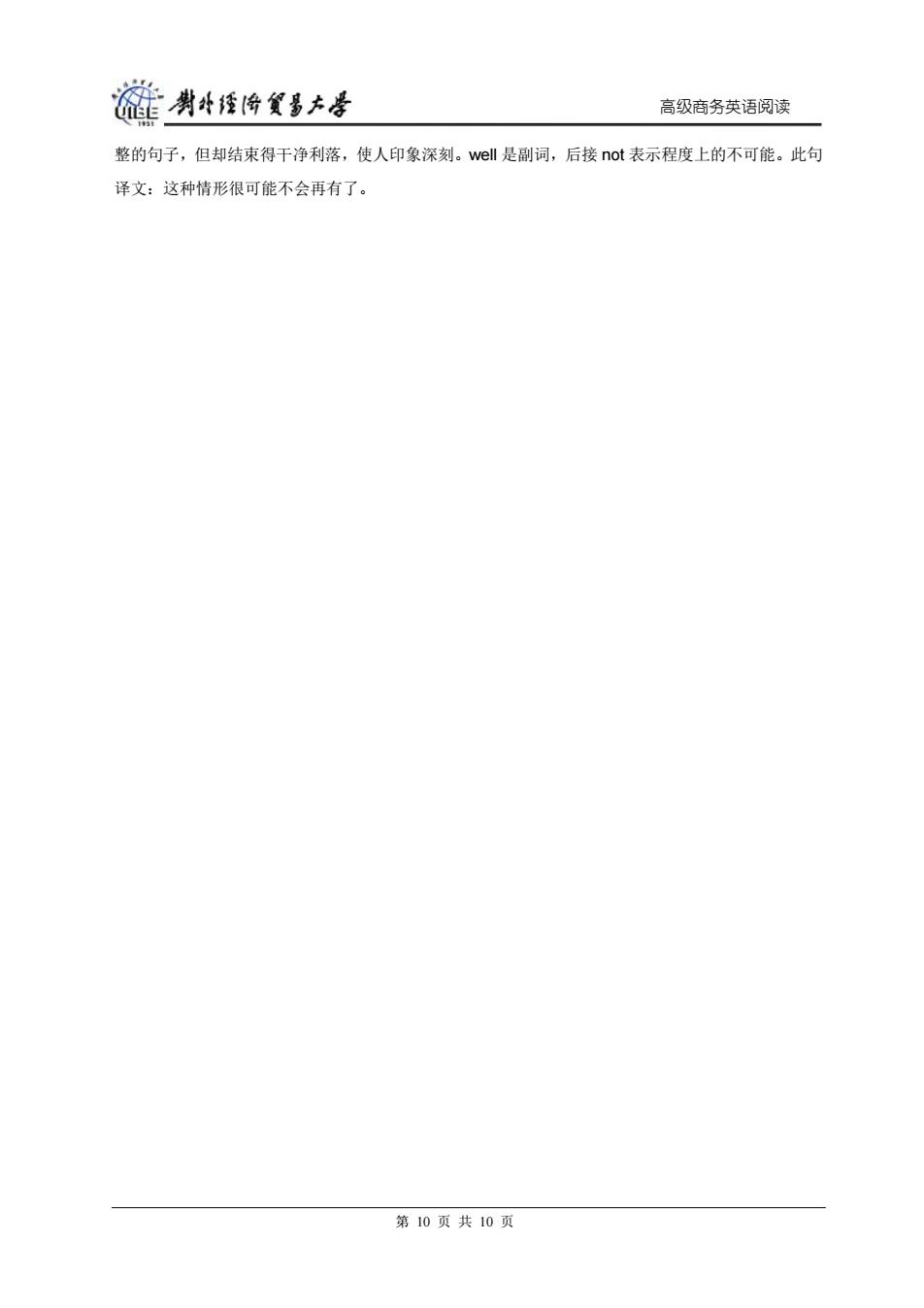
旋剥经降贸墨去号 高级商务英语阅读 整的句子,但却结束得干净利落,使人印象深刻。well是副词,后接not表示程度上的不可能。此句 译文:这种情形很可能不会再有了。 第10页共10页
高级商务英语阅读 整的句子,但却结束得干净利落,使人印象深刻。well 是副词,后接 not 表示程度上的不可能。此句 译文:这种情形很可能不会再有了。 第 10 页 共 10 页